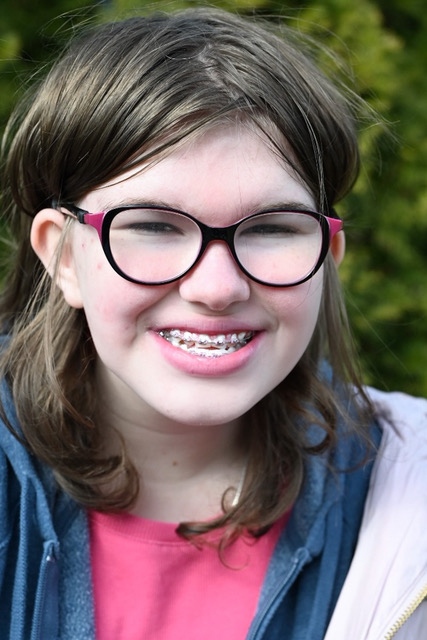
Maja
Navigating MED13L syndrome with resilience, compassion, and a belief in endless potential.
Profile Type:
- Family
|
Age Group:
- 14-17
|
Profile Created: April 28, 2025
Our Story
I have chosen to share my daughter’s story in the hope of offering encouragement to parents who have recently received a diagnosis of MED13L syndrome and now find themselves facing uncertainty. I know how emotionally overwhelming that moment can be—full of fear, confusion, and questions without clear answers. However, I want to emphasize that this is not a life sentence. Although MED13L syndrome is complex and challenging, it does not rule out the possibility of a life filled with closeness, progress, development, and joy. Maja’s story shows that it is possible to live with a good degree of independence, a rich emotional world, meaningful social connections, and true happiness.
Maja is currently almost 16 years old. She was born at 39 weeks via cesarean section, performed due to a pathological CTG recording and irregular fetal heart rate. The delivery was without complications, and her condition at birth was rated 9 on the Apgar scale. Her birth weight was 2850 grams, which is approximately 6 pounds and 4 ounces. The pregnancy was high-risk and complicated by preeclampsia (EPH gestosis), hypothyroidism, and gestational diabetes. After birth, Maja failed to gain weight adequately and showed delayed motor development—she didn’t turn her head, couldn’t tolerate tummy time, and never crawled or scooted. Neurological exams revealed increased muscle tone and a characteristic scissoring posture of the lower limbs.
In her first year of life, Maja began to say a few words, including some multisyllabic ones. However, at 13 months, she experienced a regression in speech and stopped using verbal communication completely, even though her understanding of language remained relatively preserved. She began walking independently at about 3.5 years old, but she still needs handrail support when going up stairs. Maja does not run; her gait is unsteady and wide-based, and she often trips due to bilateral clubfoot. She moves independently in daily situations but uses a specialized wheelchair for longer outings and trips to increase comfort and safety. To support her gross motor skills, she regularly rides a three-wheeled bike.
Neuroimaging (MRI of the brain) showed no significant abnormalities. Her hearing is normal. EEG recordings revealed irregularities, although Maja has never experienced seizures. Echocardiography ruled out congenital heart defects. An eye exam confirmed significant farsightedness (+5.0 diopters), which requires full-time corrective glasses. Physical examination revealed clinodactyly of the fifth fingers and subtle facial features, although not enough to meet the criteria for a clinically defined dysmorphic syndrome.
Genetic testing using whole-exome sequencing (WES), performed by the Department of Genetics at the Medical University of Warsaw, identified a de novo heterozygous mutation in the MED13L gene (c.4234_4237del, p.Tyr1412GlyfsTer29), resulting in a frameshift and premature stop codon. This variant had not previously been described in the literature, but bioinformatic analysis classified it as highly pathogenic. Additionally, a variant of uncertain significance (VUS) in the MECP2 gene was detected, though it has no phenotypic expression—Maja does not present with classical Rett syndrome symptoms.
A diagnosis of MRFACD (MED13L-related intellectual disability disorder) was made. This is a rare monogenic disorder characterized by global developmental delay and intellectual disability. In Maja’s case, the clinical picture includes: moderate intellectual disability, hypotonia, ataxia, childhood apraxia of speech, dysarthria, atypical autism, major motor coordination difficulties (dyspraxia), and progressive kyphoscoliosis. No self-injurious behaviors have been observed.
Maja is a cheerful, empathetic person who easily forms emotional connections. She loves physical contact, especially cuddling, and has a well-developed sense of humor. She can be jealous of younger children and reacts strongly to the emotions of others. She is also highly musical—she loves singing and dancing, which brings her great joy and helps her express emotions.
She uses AAC (TD Snap) to communicate. She can read whole words (global reading), recognizes letters, writes selectively, counts using concrete objects, and works with the Numicon system. She receives individual instruction at a special education school and simultaneously participates in a homeschool program based on the American Montessori Middle School curriculum.
Maja is very comfortable using technology. She independently writes short text messages and enjoys using the computer and tablet. Her favorite form of entertainment is watching YouTube videos, and she also loves playing board games—especially Uno, Rummikub, and Monopoly.
To support her cognitive and communication development, Maja regularly attends transcranial direct current stimulation (tDCS) therapy, which promotes neuroplasticity and stimulates brain areas responsible for speech.
MED13L syndrome is inherited in an autosomal dominant pattern, but in Maja’s case, the mutation occurred de novo. Her clinical course is considered mild compared to other known cases—there are no multi-organ defects, and her development has been possible thanks to consistent, intensive intervention. At present, there is no cure for the condition; treatment is symptomatic and involves comprehensive, interdisciplinary care: physical therapy, speech and psychological therapy, sensory integration therapy, tDCS, and individually tailored special education.
Despite the diagnosis, Maja leads a life full of closeness, happiness, growth, and relationships. She continues to be a source of strength and inspiration to those around her.

